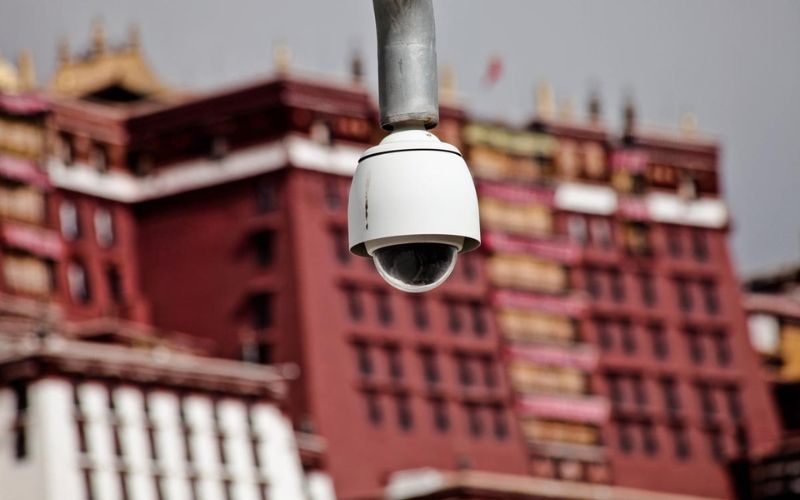
A major recent development inside Tibet Autonomous Region (TAR) has been the development of a smart platform called “Smart Construction Sites” in housing and municipal projects.
According to Bitter Winter report, China has been strongly promoting the establishment of “Smart Construction Sites” in the TAR as a latest tool to further strengthen its intrusive mass surveillance and oppression against Tibetans.
On 26 September, the Department of Housing and Urban-Rural Development of the Tibet Autonomous Region organized an on-site observation meeting of TAR’s housing and municipal engineering project “Smart Construction Site” in Lhasa city.
The "Smart Construction Site" initiative is a comprehensive platform designed to enhance the efficiency and supervision of housing and municipal projects in TAR through the utilization of advanced technologies such as big data, machine control, smart devices, and mobile terminals. What is alarming, however, is that since May 2023, the Chinese government has mandated that all eligible new housing and municipal projects in the region integrate with the "Smart Construction Site" platform.
The Department of Housing and Urban-Rural Development of the Autonomous Region has reported that the platform's construction has been completed in seven cities and thirty-four counties, with 231 projects already connected to it.
While the "Smart Construction Sites" are promoted as a means to modernize the TAR, concerns persist regarding their potential exploitation for intrusive surveillance. Tibet has long been labeled as one of the most heavily surveilled regions on Earth, and this latest development threatens to reinforce that reputation.
One facet of the security infrastructure established by Chen Quanguo during his tenure as Party Secretary of the Region (2011-2016) was an integrated neighborhood grid surveillance system. This system combines human intelligence, real-time face-recognition surveillance footage, and extensive data analytics. Notably, the Chinese surveillance cameras and facial recognition technology are the backbone of this grid system, even incorporating traffic surveillance cameras to monitor Tibetans.
Of particular concern is the massive installation of cameras in densely populated areas and cities across TAR, including Lhasa, Shigatse, Lhoka, Chamdo, Nagchu, and Ngari. These cameras are believed to be used for policing and repressive purposes, further amplifying the already intrusive surveillance in Tibet. The blurring of lines between civilian and military infrastructure in the region through the implementation of "Military Civilian Fusion" (MCF) has raised concerns, with the mass installation of cameras being disclosed in a tender published in May 2022.
According to Hao Lidong, Deputy Director of the Department of Housing and Urban-Rural Development of the Autonomous Region, the "smart construction sites" reduce supervision costs, improve efficiency, strengthen management, and relieve local supervision pressure. Beijing's promotion of this initiative aligns with China's national strategy for the construction of a digital government and modernization of the national governance system, as outlined in the "People's Government of Tibet Autonomous Region's Plan for Strengthening Digital Government Construction in the Tibet Autonomous Region (2023-25)."
To fully comprehend Beijing's promotion of "Smart Construction Sites," it is essential to consider the historical context. Since the illegal annexation of Tibet in the 1950s, China has implemented intrusive and often oppressive surveillance systems to closely monitor Tibetans in both TAR and other regions that were once part of independent Tibet. This surveillance goes hand-in-hand with arbitrary detentions of Tibetans and serves as a tool of oppression. The recent RAND report highlights the existence of vast prisons and detention centers across Tibet.
The Central Tibetan Administration asserts that the surveillance system in Tibet primarily targets Tibetans, leading to arbitrary arrests and detentions for activities including expressions of Tibetan identity, disapproval of governmental policies, peaceful protests, resistance against political re-education campaigns, possession of images of His Holiness the Dalai Lama, sharing information on human rights violations, and maintaining contacts with Tibetans in exile. The widespread installation of surveillance cameras through the "Smart Construction Sites" adds to the arsenal of intrusive surveillance tools used against Tibetans, alongside programs such as "village-based cadre teams," "Double-linked Household" social control, 5G surveillance, and coercive mass DNA collection using Thermo Fisher's DNA kits.
As Tibetans remain under the watchful eye of these ever-expanding surveillance networks, concerns for their civil liberties and human rights continue to mount. The world watches closely as Tibet faces an uncertain future under these increasing technological pressures.
Edited and collated by Team TRC